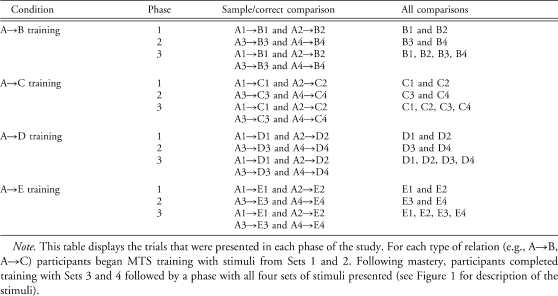Table 1.
Training Sequence
| Condition | Phase | Sample/correct comparison | All comparisons |
| A→B training | 1 | A1→B1 and A2→B2 | B1 and B2 |
| 2 | A3→B3 and A4→B4 | B3 and B4 | |
| 3 | A1→B1 and A2→B2 | B1, B2, B3, B4 | |
| A3→B3 and A4→B4 | |||
| A→C training | 1 | A1→C1 and A2→C2 | C1 and C2 |
| 2 | A3→C3 and A4→C4 | C3 and C4 | |
| 3 | A1→C1 and A2→C2 | C1, C2, C3, C4 | |
| A3→C3 and A4→C4 | |||
| A→D training | 1 | A1→D1 and A2→D2 | D1 and D2 |
| 2 | A3→D3 and A4→D4 | D3 and D4 | |
| 3 | A1→D1 and A2→D2 | D1, D2, D3, D4 | |
| A3→D3 and A4→D4 | |||
| A→E training | 1 | A1→E1 and A2→E2 | E1 and E2 |
| 2 | A3→E3 and A4→E4 | E3 and E4 | |
| 3 | A1→E1 and A2→E2 | E1, E2, E3, E4 | |
| A3→E3 and A4→E4 |
Note. This table displays the trials that were presented in each phase of the study. For each type of relation (e.g., A→B, A→C) participants began MTS training with stimuli from Sets 1 and 2. Following mastery, participants completed training with Sets 3 and 4 followed by a phase with all four sets of stimuli presented (see Figure 1 for description of the stimuli).

